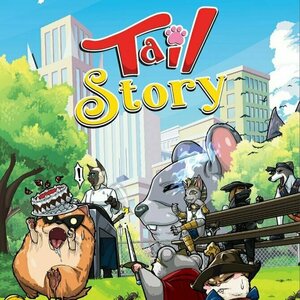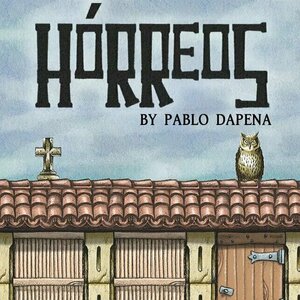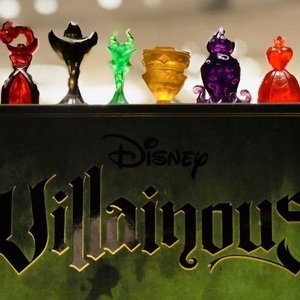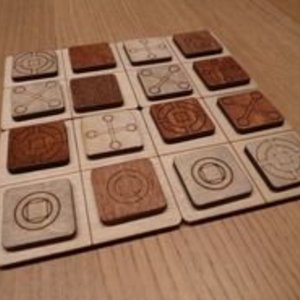Purple Phoenix Games (2266 KP) rated Tail Story in Tabletop Games
Jul 1, 2020
Disclaimer: We were provided with a preview copy of Tail Story for the purposes of this review. Some of the components pictured are not final, and will be addressed in production. Also, I do not intend to rehash the entire rulebook, but rather provide an overview of the rules and game flow. -L
Tail Story is a competitive card game in which players are racing to become the most memorable pet in history! How? By partaking in various events and gathering a total of 4 Achievements. Here’s how it works. To setup, each player takes a player mat, and randomly draws a Queue Card. Players then get to choose a Character card – a pet from either the Canine, Feline, or Rodent & Friends type. Shuffle the Event cards, deal 15 to each player, everyone draws 5 cards to their hand, and the game is ready to begin! The player who drew Queue Card 1 is the first player, and play continues in numerical order.
Each turn consists of 5 steps: Draw, Play, Bonus, Deck Check, and End of Turn. The first step is always to Draw 1 card from your deck. In the Play Step, you choose one action to perform. Each player has 2 Action Points (AP) per turn, and those are spent here in the Play Step. All Event cards require either 1 or 2 AP to play, and the other standard actions in the Play Step require either 0 or 1 AP to perform (Check out the Reference Cards pictured below to see the possible actions). After performing 1 action, you move to the Bonus Step, where a player may choose to activate a Bonus ability. The Deck Check step is next. All players count how many cards remain in their Draw piles. If all decks still have at least 1 card, you jump back to the Play Step and perform another action. If any deck is out of cards, that player reshuffles their discard pile, and places a card from their hand face-down on their player mat to signify that they have collected an Achievement. Even if another player collects an Achievement on your turn, play then returns to you, and you jump back to the Play Step again. The last step is the End of Turn – a player decides to be done and ends their turn, discarding their hand down to 5 cards. The game ends when a player has collected their 4th Achievement.
Here’s a neat twist though – whenever you play a card, any opponent can choose to play a Stop card to prevent you from performing that action! And then, if you have a Stop card too, you could play it to cancel out their Stop card. This twist adds a strategic and competitive element to the game that elevates it to the next level. There’s a fun little element of role-play too that encourages you to get into your animal character – I’ll leave that for you to discover on your own!
I know that seems like quite a lot, but once you get into the swing of things, Tail Story plays pretty quickly. One thing I particularly like about this game is that it requires a decent amount of strategy. Everyone is racing to get through their Draw decks and collect Achievements, while at the same time hindering the progress of their opponents. Are you willing to risk a valuable Stop card to cancel the action of an opponent and hope that they don’t play a Stop card back to you? Should you play a card that could activate your Bonus ability now or wait for your next action to pull a fast one over on your opponents? Your strategy has to be adjustable on the fly depending on what cards your opponents are playing. There is no single right strategy to win, and the riskiness makes the game more exciting and engaging.
Another thing I really like about Tail Story is that there are really only 4 different Event cards that can be played. Yes, the artwork may vary, but ultimately the actions are the same. They rely on key text and color coding to communicate their uses, and after a few rounds, recognizing those effects is easy. One thing I wish is that the reference cards had these effect explanation instead of only being listed in the rulebook. Just for a quick glance if you need a reminder instead of having to look back in the rules for the full text. The reference cards do have the Turn Steps and possible Actions on them, which are helpful – don’t get me wrong!
I would recommend Tail Story at the higher player counts for maximum enjoyment. With only 2 players, it feels like it drags on a bit because it is only a back-and-forth game. With 3-4 players, you have more opponents with which to interact, and playing cards against others doesn’t feel as targeted and keeps the game play more light-hearted than cut-throat.
Let’s talk about components. As I mentioned earlier, this is only a preview copy of the game, so some elements are still not finalized. The player mats are only paper right now, but I anticipate that they will be sturdier in final production. That being said, the information on the player mats is awesome. They provide enough information to understand where everything goes, while not being so wordy that they are confusing. I am excited to see what kind of color scheme they come up with for the player mats, to match the artwork of the cards. On to the cards – they are amazing. For starters, the cards are nice, sturdy, and thick. Definitely a game that will not easily succumb to bent corners or torn cards. The actual artwork of the cards is perfect. Each card is detailed, colorful, and appropriate for their respective card names. Probably the coolest part of the cards is that they all have a holographic finish on them. This really makes the artwork pop and makes you admire every card instead of just reading the text. That being said, the holographic finish makes the cards stick together a little more – not a huge detriment, but something to be aware of and careful with when drawing or playing cards! The game box is a cute little box with a magnet closure that is perfect for easy transportation.
Overall, I would say that I love Tail Story. It’s fun, fast-paced, strategic, and exciting. Being able to choose from 3 Character types (Canine, Feline, Rodent & Friends) gives you the opportunity to play a different game, with a different strategy, every time. With more plays, the special text of cards is engrained in your head, which means that it can play even faster and with no interruptions to check rules. It’s definitely a memorable game, and one that I can see myself pulling out often on game nights. I am excited to see this campaign launch, and for the sake of all animal dreams out there, you should check it out!

Volleyball Strategy Tool
Sports and Utilities
App
Get it NOW for JUST $0.99!!! Volleyball Strategy Tool is a fully universal app, compatible with...
Purple Phoenix Games (2266 KP) rated Horreos in Tabletop Games
Jan 23, 2022
Hórreos is a 2-player game in which players are competing to build the most effective and aesthetically pleasing hórreo in town. What is a hórreo? It is a building for storing grain, elevated from the ground to prevent rodents from infiltrating the structure. So in this game, players are building long and ornate hórreos that not only look stunning, but can keep the rats out of the grain! To setup for a game, each player receives 2 Action cards and the Hórreo cards are shuffled. The deck is placed between the players, and the top card is placed beside the deck to form a 2-card Market. The Leader card is placed beside the Market, facing the starting player. Pictured below is the setup for the beginning of a game.
Over a series of rounds, players will be taking 1 of 4 possible actions as they attempt to build the highest-scoring structure. Each player has 2 Action cards at their disposal. Each Action card has 2 possible Actions on it – one card is Sabotage or Plan, the other is Steal or Build. Both players will secretly choose whichever Action they wish to perform this turn, and place their card face-down in front of them. Players will then simultaneous reveal their chosen Actions, and they will be resolved in the following order – Sabotage, Plan, Steal, and Build. If a player has chosen to Sabotage, they will rotate their opponent’s Action card, forcing them to perform the other listed action this round. To perform the Plan action, the player will select one of the cards from the Market to be placed into their personal supply tableau. If you have chosen to Steal, you will select a card from your opponent’s supply, and take it into your own supply tableau. And finally, to Build is to move a card from your supply to your hórreo. Cards in your hórreo cannot be stolen. As with many other ButtonShy games, cards in your hórreo may be placed adjacent to, or even overlapping, previously played cards – cards may never be tucked under cards in your existing hórreo.
If both players have chosen the same action, the player with the Leader card facing them gets to decide which player will resolve their action first. The Leader card is then rotated to face the opposite player, and so on, for future ‘ties’. An important note – you cannot pick the same Action twice in a row, you must pick one of the other 3 Actions. So take that strategic tidbit into consideration when deciding what to do each round! The game continues in this fashion, with players selecting/simultaneously revealing Actions, resolving their Actions in order, and building their hórreo until there is 1 or fewer cards left in the Market and the players’ supplies at the end of a round. At that point, the game ends, points are tallied, and the winner is declared!
Points are scored in several ways. Most of the hórreo cards are ‘decorated’ with crosses and pikes, and each pair you have in your final hórreo will earn you points. Similarly, the number of doors in your hórreo, as well as adjacent pillars supporting your structure, will earn you points dependent upon the number (the more doors you have, the more points you earn, etc.). As mentioned earlier, you’re trying to keep these pesky rats out of your grain, so any rat pictured on your cards is worth -2 points, but each owl you have pictured eats (cancels out) one rat. And of course, whichever player has build the longest hórreo earns extra points. All points are tallied, and the player with the highest score is the winner!
I have to admit that Hórreos surprised me. The gameplay seems simple enough, so I honestly wasn’t really expecting a lot from this game. For such a small game, Hórreos is all about strategy. Each round, you only have 4 Actions from which to choose, and that really forces you to think long-term with your strategy. But at the same time, since Actions are revealed simultaneously and resolved in a set order, you have to consider what your opponent might do. For example, the Sabotage action forces the opposing player to use the other Action of their chosen card this round. Can you bluff your opponent into playing that Sabotage, forcing you to switch Actions, thus letting you perform the Action you really wanted to perform? That goes hand in hand with the fact that you cannot choose the same Action twice in a row. Can you anticipate your opponents moves to benefit your strategy? Or will you be out of touch, and thus be forced to essentially waste a turn performing an Action that you actually didn’t want to? And don’t forget the Leader card – if players both pick the same Action, the Leader can decide who resolves first. Maybe it’s strategically better to let your opponent resolve first, so then you can just negate what they just did, or vice versa.
To touch on components for a minute, this is a game of 18 cards in a wallet. So nothing out of the ordinary for ButtonShy. That being said, production quality is always top notch with these games, and I have no complaints. the cards are thick and sturdy, and the wallet is nice and supportive. The artwork is thematic and refreshing, while not being too overwhelming. Is it the most beautiful game I’ve ever seen? No. But it is aesthetically and thematically appropriate, and gives a serene and peaceful vibe. ButtonShy has yet to disappoint with their components, so I am definitely a big fan!
Hórreos is a pretty solid game. I’m not personally a huge fan of ‘take that’ type games, and there is an element of that in this gameplay. But there seems to be enough strategy needed to negate some of that direct competitiveness. The game itself is fast to teach, learn, and play, and that adds to the overall appeal. It’s not necessarily my favorite 2-player game, but it’s one that I can see myself pulling out often when I’ve got a quick minute between other games, or when I’ve got a little downtime. Purple Phoenix Games gives this one a structural 4 / 6. Check it out if you’re in the market for something small, yet strategic!
Purple Phoenix Games (2266 KP) rated Disney Villainous in Tabletop Games
Jan 6, 2020
Disney Villainous (“Villainous” from here on) is a card game that pits players against each other in a race to complete individualized objectives to win the game. Players are in direct competition with each other and have devices to employ to spoil the plans of their competitors. Can Maleficent place out curses on all the lands in her realm before Hades can have three Titans storm on Mount Olympus? Can Prince John attain 20 power before either of them win the game? Such is Villainous.
DISCLAIMER: This game has a few standalone expansions now, with more on the way I’m sure. We are using components from the base game as well as the first expansion, “Wicked to the Core,” for this review. Should we decide to review the expansions as standalone games, we will link to the new material here. Furthermore, I do not intend to cover every single rule included in the rule book, but will describe the overall game flow and major rule set so that our readers may get a sense of how the game plays. For more in depth rules, you may purchase a copy from the publisher directly or from your FLGS. -T
To setup, each player will choose a big bad to play. Each character comes equipped with a colored pawn, a realm board with four locations, a deck of cards with matching pawn colored backs, a Fate deck with white back, and a playbook with tips on how to play that character. Also give every player a reference card that details the actions available. Shuffle each deck separately, give the starting player zero power from the cauldron, the second player one power, the third player two power, etc. Each player draws a hand of four colored back cards. Begin the game with the pawns on the leftmost location on the realm board and you are now ready to play.
Play works thusly: move your pawn to any unlocked location, complete any or all actions available at the location, draw your hand back up to four, next player. You MUST move on your turn, unless a card allows you to stay at your current location on your next turn. Once moved, the location will either show two or four options for actions. These could include play a card, activate a card, discard a card, gain power tokens, move an item or ally, move a Hero card, vanquish a Hero, or play cards from an opponent’s Fate deck. Some actions are self-explanatory (gain power tokens, et al), but some require further explanation.
Some cards will have an activation symbol displayed on them. This means that a pawn has to have been moved to a location with an activate card symbol, and the player must pay to activate the card for its special abilities. Easy. Moving an item, ally, or Hero typically means physically moving the cards from one location to another adjacent location. This is important for some villains’ objectives: cards need to enter play in one location but travel to another as part of the win condition. When a villain moves to a location with the Fate symbol, they will choose an opponent, look at the top two cards of their Fate deck, and choose one card to play and one card to discard. These are especially devious and can greatly hinder the player’s progress. In addition, when a Fate card resides on a realm board it covers the top symbols of a location, thus nullifying the player’s ability to use these symbols on future turns. Using the vanquish symbol requires a Hero to have been played on your board, and having enough strength in allies and items to meet or overcome the Hero’s strength. Heroes and any allies/items used in the fight are then all discarded to the appropriate discard piles.
Play continues in this manner until one player has achieved their victory condition.
Components. I have good and bad news. Good news first. The components are absolutely fabulous! Those pawns. SOOOO good. Each is a somewhat abstracted figure of the villain, but with some concrete callbacks and recognizable features. They are just so dang fun to handle and play with. I think the cards are good quality, but I forgot what they feel like outside of the sleeves I put mine in. The board components are great, the cauldron is flimsy, unnecessary, and unwieldy when putting back in the box, especially if you have one or more expansions. I have not found a decent way to put everything back in one box, so I am resigned to having both boxes with me every time I want to play. That’s the bad. I also have put all my sleeved cards into plastic deck boxes in the main game box along with the cauldron. Everything else gets put in the expansion box. I hope a better storage solution is on the horizon along with future expansions…
So as you can see from our rating graphic on top that we are spread out on this one. I love it, but I don’t see it ever breaching my Top 10 list. It does have a tendency to overstay its welcome with all the Fate cards making it more and more difficult to win the game. Once a player seems to be near winning every other player gangs up, or seems to when I have played. I get that it may come off as a negative, and the play length as well, but it’s all part of villains out-villaining each other. While Josh rated it as a three and may not ever willingly ask to play it, I have it at a five because I think it’s a great game with a wonderful theme, amazing components, and tons of expandability. With that, we at Purple Phoenix Games give Disney Villainous a boding 16 / 24. If you are a big Disney fan, can live with the Take That, and want something that looks incredible on the table, pick it up.
Purple Phoenix Games (2266 KP) rated Mijnlieff in Tabletop Games
Mar 3, 2021
Typically I explain the theme here and what players’ end goals are. Mijnlieff is a two player abstract strategy game that has no real theme, though the art style uses lots of leaf iconography and the color scheme is very Autumnal. The winner of Mijnlieff is they who score the most points at the end of the game by constructing the most (or longest) sets of 3 tiles in a row.
DISCLAIMER: We were provided a copy of this game for the purposes of this review. This is a retail copy of the game, so what you see in these photos is exactly what would be received in your box. I do not intend to cover every single rule included in the rulebook, but will describe the overall game flow and major rule set so that our readers may get a sense of how the game plays. For more in depth rules, you may purchase a copy online or from your FLGS. -T
To setup each player will choose a color of tiles (or I guess just one player chooses and the other is stuck with the unchosen), and the back of the game bag is placed on the center of the table to act as the game board. Decide the starting player and the game may begin!
On a player’s turn they must place one of their tiles on one of the leaf symbols printed on the bag (the leaf symbols mean nothing other than to show where to place tiles). Easy. The first player will place their very first tile on one of the outermost leaf symbols to begin the game. The second player will then place their tile on the board depending on which tile was just placed by their opponent. You see, in Mijnlieff players cannot just place tiles willy-nilly, no! The tile immediately placed dictates where the next tile may be placed.
For example, if an opponent had just placed the N/S/E/W cross tile (Straight), then the next tile may only be placed on one of those leaves pointed at by the cross. Similarly with the diagonal cross (Diagonal) for diagonal leaves. The leaf tile with a solid circle around it (Puller) instructs the next player to place their tile on any leaf space that touches the original tile, even diagonally. Conversely, the leaf tile with a broken circle (Pusher) means the opposite: the next tile may be placed in any space that is NOT able to touch the original tile.
Players have access to two tiles of each flavor and they are attempting to rid their hand of tiles and create the most lines of three or four tiles for one or two points respectively. Once one player rids themselves of all their tiles the next player may lay just one last tile in an attempt to score more points. Whichever player earns the most points is the winner and, undoubtedly, will wish to play again immediately afterward.
Components. The version I was sent is the most recent XVgames Bagstracts edition in the fancy brown bag. The bag is great, and not only carries the components but doubles as the game board. I mean, I have not really seen that anywhere else. What a great and versatile component. The tiles are all very nicely painted wooden tiles with very clear iconography, which is much appreciated. The rulebook is fantastic and explains the game splendidly. Also included is a set of modular 2×2 mats that can be assembled in ANY fashion to create personalized game boards. I think this is a wonderfully-produced game with excellent components. The art is minimal but effective, and it has orange as a main color, so I applaud that choice as well.
The gameplay is what I would like to rave about here. My wife and I enjoy abstract strategy games together, but I have never seen her be absolutely magnetized to a game as much as she is to Mijnlieff. Right away, the first day I asked her to play it with me we ended up playing it eight or nine times that day. And you know what? We both really were jonesing to play some more. The game is relatively quick, with games lasting around 10 minutes each, but the neural exercises happening whilst playing is such so fantastic.
None of the tiles’ actions are difficult to understand, but each time a tile is placed my mind is racing with possibilities for my next turn. I do not suffer from Analysis Paralysis (AP), and my wife usually takes her times, but I do sit and think a bit more playing Mijnlieff. Sometimes you just need to play a tile to block the other player. You see, if you lay a tile and your opponent is unable to lay a tile legally according to your tile’s actions, then you get to place another tile ANYWHERE on the board. This could lead to a cascade of several tiles being laid on a turn, and THAT is what makes this simply an amazing design.
I now have four titles by designer Andy Hopwood that I will be reviewing, and if any of them are as thoughtful, beautiful, and well-designed I may have found another designer to add to my list of favorites. Purple Phoenix Games (plus my wife) give this one an incredibly respectful 11 / 12. I think what could make this game better is blinged out components. Everything in this bag is great, but Mijnlieff screams for high quality components and just sparkle everywhere. If you need a thinky abstract for two players from a smaller publisher and designer, I plead with you to grab a copy of Mijnlieff. I find it to be a superior design, quick-playing, and just hits all the right spots for my wife and me. And once you receive your copy we can record ourselves pronouncing the title and sending our recordings to the designer for him to choose the closest butchering.
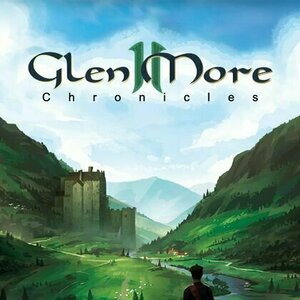
Glen More II: Chronicles
Tabletop Game
Glen More II: Chronicles is a sequel to Glen More, expanding the gameplay substantially compared to...

Baby Car Driving App - Toy Car Games For Toddlers
Entertainment and Games
App
Baby Car is a fun baby driving app with lots of activity and musical treat for the little one. Have...

My Video Manager and Filetransfer
Photo & Video
App
Easy to video viewer and local video transfer My Video Viewer is for download local network from...

Player Piano 3D
Music and Education
App
Discover, learn, play and create piano songs with this all in one piano app, featuring jaw dropping...
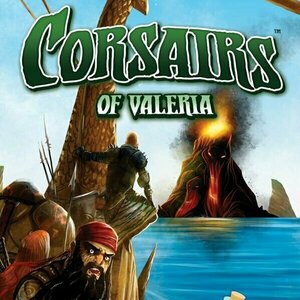
Corsairs of Valeria
Tabletop Game
With the current Commodore lost at sea, you and your fellow Corsairs have set out to complete the...
